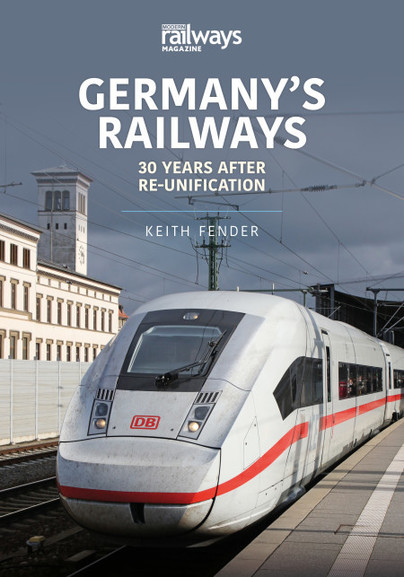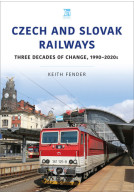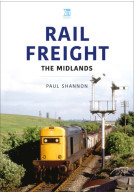Germany's Railways (Paperback)
30 Years After Re-Unification
Imprint: Key Publishing
Pages: 96
Illustrations: 130
ISBN: 9781913870065
Published: 3rd May 2022
(click here for international delivery rates)
Order within the next 9 hours, 43 minutes to get your order processed the next working day!
Need a currency converter? Check XE.com for live rates
| Other formats available | Price |
|---|---|
| Germany's Railways ePub (12.5 MB) Add to Basket | £9.99 |
Germany, divided after World War II into two separate countries, was re-unified on 3 October 1990. For the country’s rail system the complex task of unifying two networks with very different rolling stock and systems had just begun. New lines and stations were built to physically unite the network and new trains were introduced to transform services. Many rural regional lines closed as car ownership in the former East Germany increased dramatically. Amazingly, however, none of the former East German narrow-gauge lines that were still steam-operated in 1990 have shut; most still offer daily services whilst other long-closed narrow-gauge lines have been rebuilt and reopened by enthusiast groups.
This book, written by the Modern Railways magazine’s Europe Editor and illustrated with over 130 pictures, most of which have never been published before, traces the development of the unified German rail network and new national operator Deutsche Bahn (DB AG). It also looks at the wider rail industry in Germany and the introduction of market reforms leading to one of the most dynamic rail markets anywhere, with over 300 rail freight operators, open access intercity competition and more than 100 regional passenger concession contracts replacing the original two state railway companies. Looking to the future, the book examines plans for new high-speed lines and a national regular-interval timetable from 2030.
Overall, this is well researched, interesting, informative, and eminently readable. It sets thirty years of rail development in context, striking a successful balance between detail and the broader picture. If nothing else, it should help modellers make sense of all the private operator liveries!
Continental Modeller
Written by Modern Railways magazine’s Europe Editor Keith Fender this new English language publication takes a look at the railways of Germany during the 30 years since the fall of the Berlin Wall. The book is split into twelve separate chapters covering subjects such as the formation of Deutsche Bahn AG from the original two systems, Deutsche Bundesbahn of West Germany and East Germany’s Deutsche Reichsbahn, re-opened and closed lines, the building of new high speed lines for the DB Fernverkehr sector, new and rebuilt stations, new international services, open access expansion, freight workings, surviving narrow gauge lines under private ownership and the new ‘Takt’ passenger service frequency due to be introduced by 2030. All of these give the reader interesting information; the first chapter, entitled ‘Introduction and Historical Overview’ in particular covers post-Second World War German history and the development of the two separate German states. Each chapter is accompanied by around ten colour photographs with detailed captions and there are shots of steam, diesel and electric motive power. Most of these are by the author himself, are generally of good quality, and have not previously been published. A Glossary of terms together with a small advertisement for magazines available from this publisher appears on the final page.
German Railway Society's magazine 'Merkur' No. 158, Spring 2021
This is a very handy, reasonably priced and well-researched reference work on an interesting period in the history of Germany’s railways which has hitherto only been available in German and comes thoroughly recommended.
Re-unifying Germany’s railways after “Die Wende” (as unification of East and West Germany was called ) was a major task for the new Germany. Few lines crossed the old border between the Bundesrepublik and the DDR. East German was well behind. It still operated steam locomotives on many narrow gauge lines and for carriage heating, also retaining an extensive rural network where car ownership was very low.
The Society of Model and Experimental Engineers Journal
To the credit of railway workers, helped by a sympathetic government, integration was achieved in a remarkably short time. The new high speed line between Hanover and Berlin was ready by 1998 and other cross border lines were reopened. Ex DDR lines were uprated but at the cost of closing most rural networks.
This brief but informative book shows the train and track improvements across the country where freight traffic plays a much bigger part than in the UK. New high speed lines have been built with ICE trains capable of 280kph (175mph) a lesson to those who’ve wanted HS2 progress in the face of many small-minded objections.
A fascinating introduction to a great railway system.
About Keith Fender
Keith Fender is a London based journalist and photographer whose writings about world railways have become well known in British and European railway magazines such as Today’s Railways Europe, Today’s Railways UK and Railways Illustrated. His photographs have been published by a wide range of magazines. His interests include world travel, sailing, railway travel, photography and rich food. He was educated at Prices College, Fareham, and the Transport Unit at Aston University Birmingham. After graduation, Fender joined Royal Mail, where he worked for many years, including spells in Argentina and Frankfurt. Fender left Royal Mail in 2004 and has been freelancing as a railway author. Since 2004, he has travelled continuously, documenting his travels in Europe, Asia, Australia, and the Americas.















